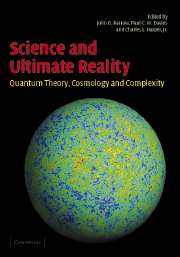 |
SCIENCE AND ULTIMATE REALITY: Edited by John D. Barrow Paul C. W. Davies Charles L. Harper, Jr
|
|
Purchase available in US and UK. Read reviews from the Times Higher Education Supplement (PhilipAnderson), Nature Books and Arts(Frank Close), and New Scientist Opinion(Michio Kaku). This preview of the future of physics comprises contributions from recognized authorities inspired by the pioneering work of John Wheeler. Quantum theory represents a unifying theme within the book, as it relates to the topics of the nature of physical reality, cosmic inflation, the arrow of time, models of the universe, superstrings, quantum gravity and cosmology. Attempts to formulate a final unification theory of physics are also considered, along with the existence of hidden dimensions of space, hidden cosmic matter, and the strange world of quantum technology. John Archibald Wheeler is one of the most influential scientists of the twentieth century. His extraordinary career has spanned momentous advances in physics, from the birth of the nuclear age to the conception of the quantum computer. Famous for coining the term "black hole," Professor Wheeler helped lay the foundations for the rebirth of gravitation as a mainstream branch of science, triggering the explosive growth in astrophysics and cosmology that followed. His early contributions to physics include the S matrix, the theory of nuclear rotation (with Edward Teller), the theory of nuclear fission (with Niels Bohr), action-at-a-distance electrodynamics (with Richard Feynman), positrons as backward-in-time electrons, the universal Fermi interaction (with Jayme Tiomno), muonic atoms, and the collective model of the nucleus. His inimitable style of thinking, quirky wit, and love of the bizarre have inspired generations of physicists.
Purchase available in US and UK.
|
|